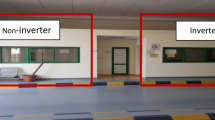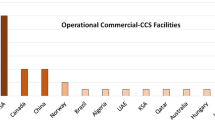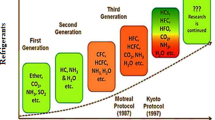Abstract
Purpose
Refrigeration and air conditioning systems have high, negative environmental impacts due to refrigerant charge leaks from the system and their corresponding high global warming potential. Thus, many efforts are in progress to obtain suitable low GWP alternative refrigerants and more environmentally friendly systems for the future. The system’s life cycle climate performance (LCCP) is a widespread metric proposed for the evaluation of the system’s environmental impact.
Methods
In this paper, the potential emission reductions in the commercial refrigeration and residential air conditioning systems, made possible by shifting towards more environmentally friendly refrigerants in the US, are presented. First, the current LCCP of the most common commercial refrigeration and residential air conditioning systems is calculated. Then, the LCCP of the baseline systems, when using the potential low GWP alternative refrigerants, is presented. This helps to determine the systems which have the highest potential for emission reductions.
Results and discussion
By shifting from the baseline refrigerants, R-404A and R-410A, to the suggested low GWP refrigerants, N-40 and L-41a, in the commercial refrigeration and residential HVAC systems, respectively, a combined drop of 30.43 % in the total emissions (i.e., total equivalent mass of emissions in kg CO2eq) is obtained. This results from a 50.5 and 28.01 % drop in total emissions from supermarket refrigeration systems and residential air conditioning, respectively.
Conclusions
Shifting to lower GWP refrigerants in the refrigeration and air conditioning systems helps to reduce the total emissions and negative environmental impacts of these systems. Shifting to a secondary circuit commercial refrigeration system using N-40/L-40 and residential air conditioning and heat pump systems using L-41a helps in reducing the total emissions.




Similar content being viewed by others
References
Abdelaziz O, Fricke B, Vineyard E (2012) Development of low global warming potential refrigerant solutions for commercial refrigeration systems using a life cycle climate performance design tool. International Refrigeration and Air Conditioning Conference at Purdue, West Lafayette, Indiana
Alabdulkarem A, Hwang Y, Radermacher R (2013a) System Drop-In Tests of Refrigerants R-32, D2Y-60, and L41a in Air Source Heat Pump. Air-Conditioning, Heating, and Refrigeration Institute (AHRI) Low-GWP Alternative Evaluation Program
Alabdulkarem A, Hwang Y, Radermacher R (2013b) System Soft-Optimized Test of Refrigerant L-41a in Air Source Heat Pump. Air-Conditioning, Heating, and Refrigeration Institute (AHRI) Low-GWP Alternative Evaluation Program
Alabdulkarem A, Hwang Y, Radermacher R (2013c) System Soft-Optimized Test of Refrigerant D2Y60 in Air Source Heat Pump. Air-Conditioning, Heating, and Refrigeration Institute (AHRI) Low-GWP Alternative Evaluation Program
Alabdulkarem A, Eldeeb R, Hwang Y, Aute V, Radermacher R (2014) Evaluation and soft-optimization for R410A low-GWP replacement candidates through testing and simulation. 15th International Refrigeration and Air Conditioning Conference at Purdue, West Lafayette, Indiana
Amrane K (2013) Overview of AHRI Research on Low-GWP Refrigerants. AHRI Low-GWP Alternative Refrigerants Evaluation Program Presentation
ANSI/AHRI (2008) ANSI/AHRI 210/240–2008 with Addenda 1 and 2, Performance Rating of Unitary Air-Conditioning & Air-Source Heat Pump Equipment
Arthur D. Little, Inc. for the account of the Alliance for Responsible Atmospheric Policy (2002) Global Comparative Analysis of HFC and Alternative Technologies for Refrigeration, Air Conditioning, Foam, Solvent, Aerosol Propellant, and Fire Protection Applications
Beshr M, Aute V, Fricke B, Radermacher R (2014) An Eevaluation of the environmental impact of commercial refrigeration systems using alternative refrigerants. 3rd IIR International Conference on Sustainability and the Cold Chain, London
Beshr M, Aute V, Sharma V, Abdelaziz O, Fricke B, Radermacher R (2015) A comparative study on the environmental impact of supermarket refrigeration systems using low GWP refrigerants. Int J Refrig 56:154–164
Burns L, Austin M, Chen C (2013) System Drop-in Testing of R-410 A Replacements in Split System Heat Pump. Air-Conditioning, Heating, and Refrigeration Institute (AHRI) Low-GWP Alternative Evaluation Program
Chen W (2007) A comparative study on the performance and environmental characteristics of R410A and R22 residential air conditioners. Appl Thermal Eng 28(1):1–7
Deru M, Torcellini P (2007) Source Energy and Emission Factors for Energy Use in Buildings, National Renewable Energy Laboratory (NREL)
Deru M, Field K, Studer D, Benne K, Griffith B, Torcellini P, Liu B, Halverson M, Winiarski D, Rosenberg M, Yazdanian M, Huang J, Crawley D (2011) U.S. Department of Energy commercial reference building models of the national building stock. Golden, CO: National Renewable Energy Laboratory, Golden, Colorado
Food Marketing Institute (2010) Supermarket Facts-Industry Overview:2010
Hwang Y, Jin DH, Radermacher R (2007) Comparison of R-290 and two HFC blends for walk-in refrigeration systems. Int J Refrig 30(4):633–641
ICF Consulting for U.S. EPA’s Stratospheric Protection Division (2005) Revised Draft Analysis of U.S. Commercial Supermarket Refrigeration Systems
ICF International, Prepared for the U.S. Environmental Protection Agency (2009) The U.S. Phaseout of HCFCs: Projected Servicing Needs in the U.S. Air-Conditioning and Refrigeration Sector
Intergovernmental Panel on Climate Change (IPCC) (2013) Fifth Assessment Report: Climate Change, Geneva, Switzerland
Kujak S, Srichai R, Schultz K (2014) Assessment of life cycle climate performance (LCCP) tools for HVACR applications with the latest next generation refrigerant technology. 15th International Refrigeration and Air Conditioning Conferenceat Purdue, West Lafayette, Indiana
Lei Z, Yanting Z (2013) System Drop-in Test of Refrigerant R-32 in Split Air-conditioning System. Air-Conditioning, Heating, and Refrigeration Institute (AHRI) Low-GWP Alternative Evaluation Program. 2013
Minor B, Montoya C, Kasa F (2010) HFO-1234yf performance in a beverage cooler. International Refrigeration and Air Conditioning Conference at Purdue, West Lafayette, Indiana
Motta SFY (2011) Low-GWP Refrigerants for Air Conditioning and Refrigeration Applications. Honeywell
Nasuta D, Srichai R, Zhang M, Martin C, Muehlbauer J (2014) Life cycle climate performance model for transport refrigeration/air conditioning systems. ASHRAE Annual Conference, Seattle
National Renewable Energy Laboratory (NREL) (2005) U.S. LCI Database. www.nrel.gov/lci
National Renewable Energy Laboratory (NREL) (2012) National Solar Radiation Data Base, 1991–2005 Update: Typical Meteorological Year 3
Papasavva S, Hill WR, Andersen SO (2010) GREEN-MAC-LCCP: a tool for assessing the life cycle climate performance of MAC systems. Environ Sci Technol 44(19):7666–7672
Pham HM, Rajendran R (2012) R32 and HFOs as low-GWP refrigerants for air conditioning. International Refrigeration and Air Conditioning Conference at Purdue, West Lafayette
Spatz MW, Motta S (2004) An evaluation of options for replacing HCFC-22 in medium temperature refrigeration systems. Int J Refrig 27(5):475–483
The Air Conditioning, Heating and Refrigeration Institute (AHRI) AHRI Low-GWP Alternative Refrigerants Evaluation Program. http://www.ahrinet.org/ahri+low_gwp+alternative+refrigerants+evaluation+program.aspx. Accessed 20 Mar 2016
The University of Maryland College Park (UMCP), and Oak Ridge National Laboratory (ORNL) (2013) LCCP Desktop Application v1 Engineering Reference. (http://info.ornl.gov/sites/publications/Files/Pub49128.pdf)
U.S. Department of Energy (DOE) EnergyPlus Energy Simulation Software. http://apps1.eere.energy.gov/buildings/energyplus/
U.S. Department of Energy, Building Technologies Program (2012) Annual Energy Outlook Early Release 2012
U.S. Environmental Protection Agency (EPA) (2007) eGRID 2006 version 2.1. Emissions and Generation Resource Integrated Database. www.epa.gov/cleanenergy/egrid
UNEP/TEAP (1999) The Implications to the Montreal Protocol of the Inclusion of HFCs and PFCs in the Kyoto Protocol
United Nations (1998) Kyoto Protocol to the United Nations Framework Convention on Climate Change
United Nations Environment Programme Ozone Secretariat (1989) Montreal protocol on substances that deplete the ozone layer final act 1987. J Env Law 1(1):128–136
US Energy Information Administration (2012a) Commercial Buildings Energy Consumption Survey (CBECS) http://www.eia.gov/consumption/commercial/reports/2012/preliminary/index.cfm
US Energy Information Administration (2012b). Residential Energy Consumption Survey. http://www.eia.gov/forecasts/aeo/assumptions/pdf/residential.pdf
Winkler J, Aute V, Radermacher R (2008) Comprehensive investigation of numerical methods in simulating a steady-state vapor compression system. Int J Refrig 31(5):930–942
Zhang M, Muehlbauer J (2011) Life Cycle Climate Performance Model for Residential Heat Pump System. Air-Conditioning, Heating and Refrigeration Technology Institute, Inc. (AHRTI)
Acknowledgments
This work was supported in part by the Oak Ridge National Laboratory (ORNL) and the Modeling and Optimization Consortium (MOC) at the University of Maryland. The authors also acknowledge the support of Building Technologies Office of the US Department of Energy for their financial support and Honeywell International Inc. for their in-kind and technical support.
Author information
Authors and Affiliations
Corresponding authors
Additional information
Responsible editor: Barbara Nebel
Supporting Information Available
This tool is available free of charge via the internet at: http://lccp.umd.edu/ornllccp/
Rights and permissions
About this article
Cite this article
Beshr, M., Aute, V., Abdelaziz, O. et al. Potential emission savings from refrigeration and air conditioning systems by using low GWP refrigerants. Int J Life Cycle Assess 22, 675–682 (2017). https://doi.org/10.1007/s11367-016-1186-6
Received:
Accepted:
Published:
Issue Date:
DOI: https://doi.org/10.1007/s11367-016-1186-6




